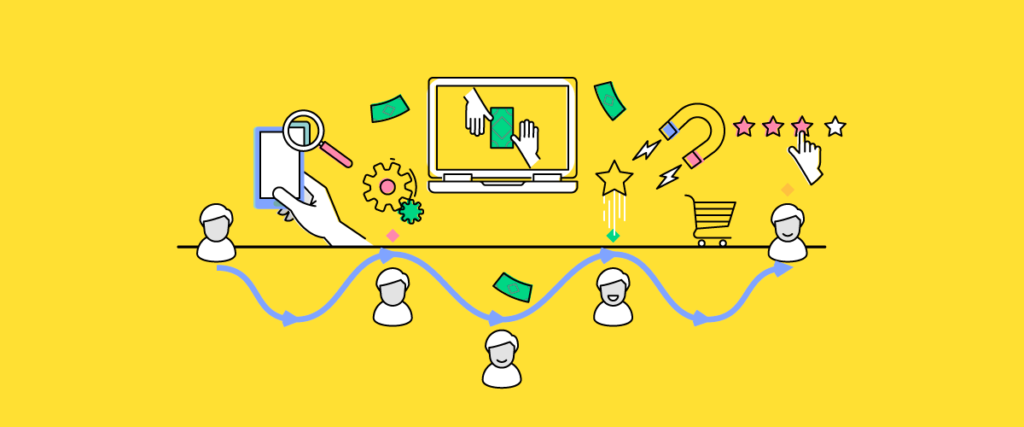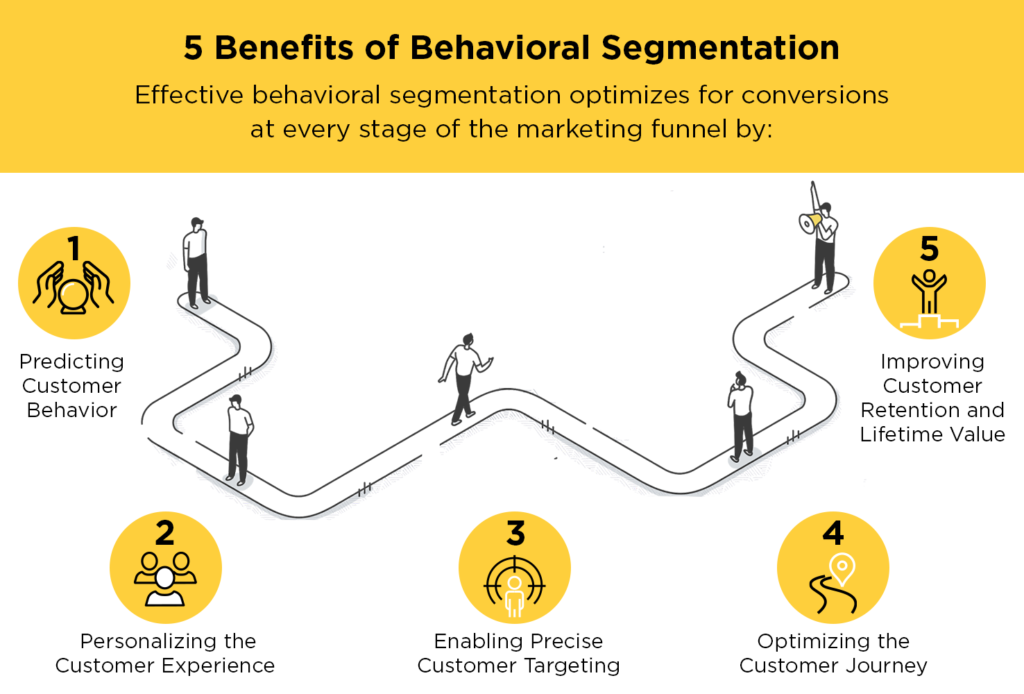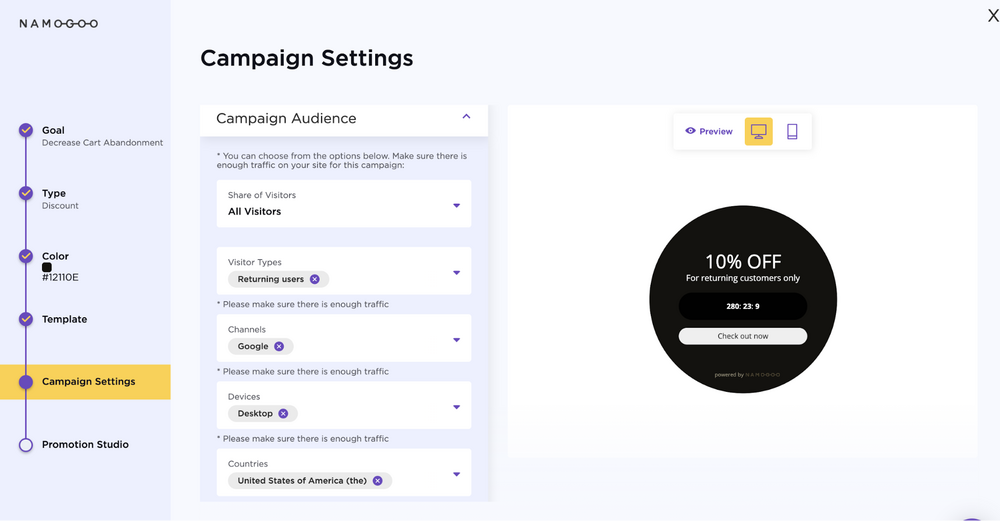
To here:
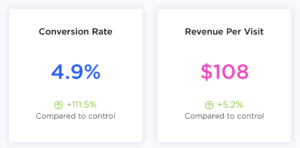
Marketing teams are well-versed in using demographics and even psychographics to build buyer personas and customer segments.
But using behavioral segmentation can make those segmentation types more powerful, allowing you to:
- Target with more precision
- Personalize the customer experience
- Optimize for revenue and conversions
- Maximize ROI and profitability.
In other words, this segmentation type and strategies that are based on customer intentions helps you deliver exactly what your customers need, when they need it to ensure customer journey continuity.
In this guide, you’ll learn what behavioral segmentation is, why it needs to be part of your marketing segmentation plan, and how to use it to fuel eCommerce growth.
What is Behavioral Segmentation?
Behavioral segmentation is an advanced segmentation technique that groups suspects, prospects, leads, and customers based on their behaviors and actions they take.
Whereas other segmentation types such as demographic and psychographic segmentation paint a picture of who the target audience or customer is, behavioral segmentation groups them by what they do.
In the B2C world, there are three main segmentation types:
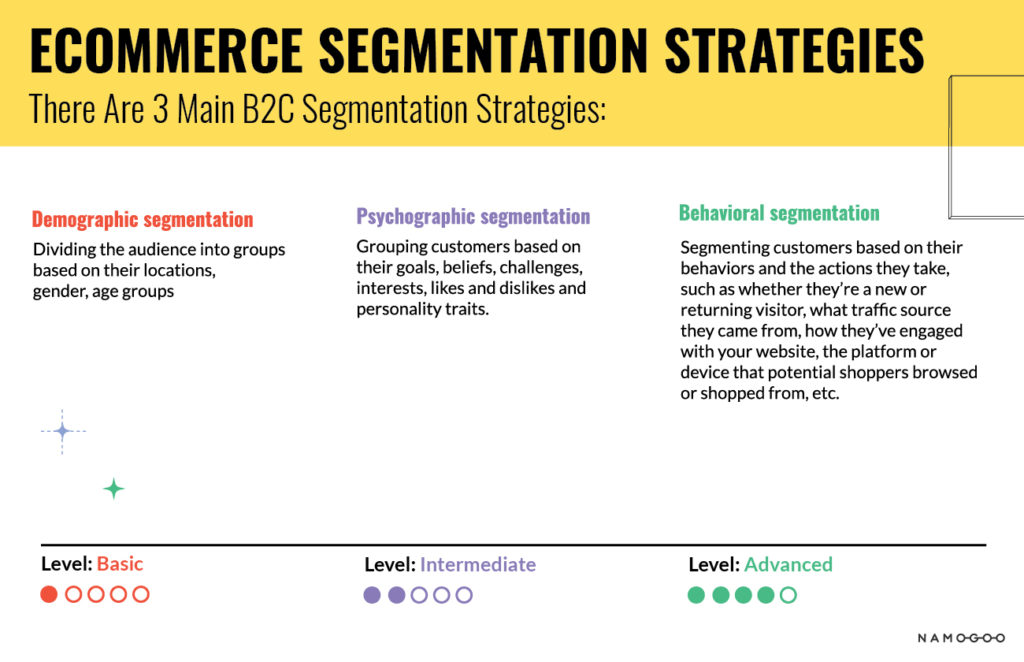
- Demographic segmentation: Dividing the audience into groups based on their location, gender, age group, etc.
- Psychographic segmentation: Grouping customers based on their goals, beliefs, challenges, interests, likes, dislikes, and personality traits.
- Behavioral segmentation: Segmenting customers based on their behaviors and the actions they take, such as whether they’re a new or returning visitor, what traffic source they came from, how they’ve engaged with your website, and the platform or device they’re using.
No segmentation type works in a silo. You need the other segmentation types for behavioral segmentation, and to get the most out of your segmentation efforts, you need behavioral segmentation.
Behavioral Segmentation vs. Psychographic and Demographics
What does behavioral segmentation do that psychographic or demographic segmentation doesn’t?
Demographics and psychographics help you to build hypotheses about how groups of customers might act, and behavioral segmentation can test the hypothesis.
To differentiate between the main segmentation methods, behavioral and psychographic, consider this example of audience segmentation for a Facebook ad campaign for a healthy travel essentials brand FLIGHTFŪD.
This should put all three segmentation types into context, and drive home not only how they all differ but how they work together.
Demographics
FLIGHTFŪD’s highest converting demographic segments are women between the ages of 25-44, accounting for over 60% of our conversions:
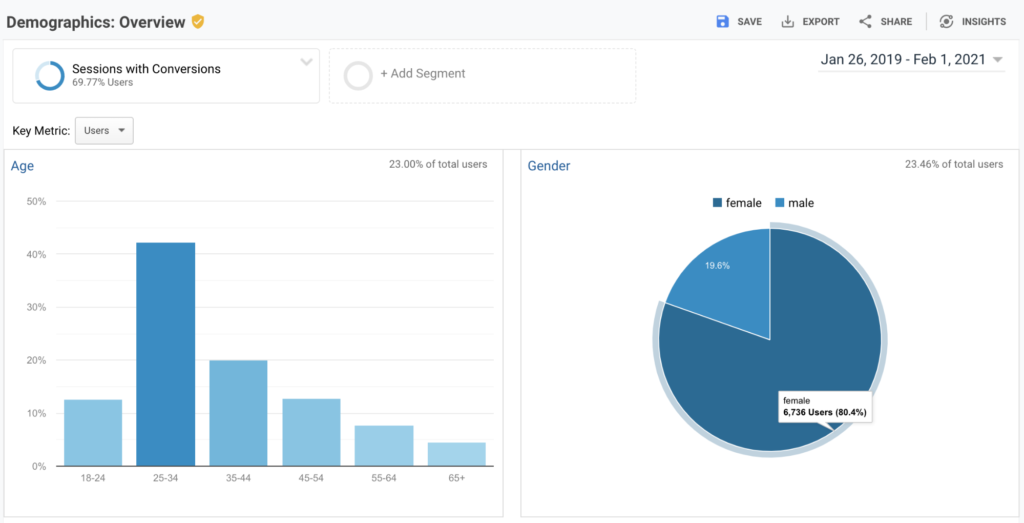
They’re concentrated in cities in the US and Canada that are closer to large, international airports.
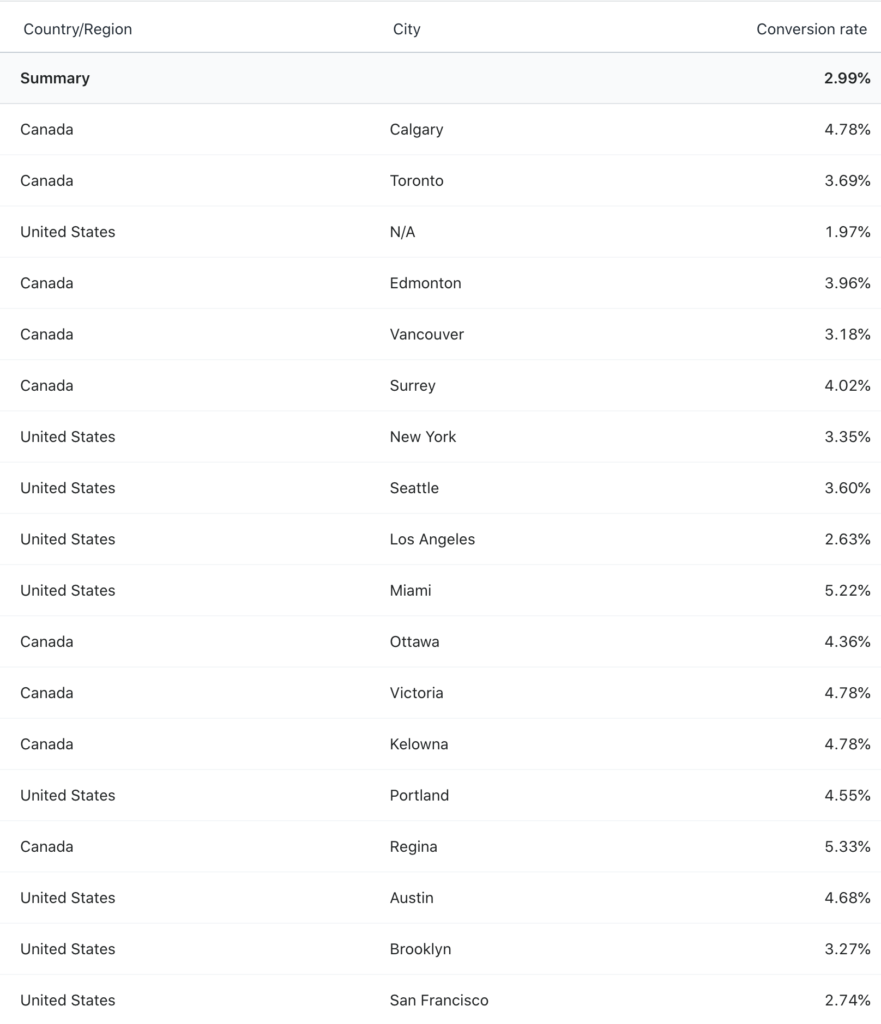 This information helps to target audiences that fall within those demographics. On Facebook, this is what the audience looks like when they segment based on these demographics:
This information helps to target audiences that fall within those demographics. On Facebook, this is what the audience looks like when they segment based on these demographics:
 A potential reach of 9,200,000 people is a large pool.
A potential reach of 9,200,000 people is a large pool.
Without psychographic or behavioral segmentation, they’d be paying to display ads to everyone in that pool, regardless of their interest in traveling and health.
This will make their impressions look impressive, but at a hefty cost, as it’ll also drive up cost-per-click (CPC) and cannibalize return on ad spend (ROAS).
Psychographics
When I add psychographics into the mix, I can narrow the audience down further.
Now instead of targeting all women between the ages of 25-44 who live in these major cities, they can target those who are interested in traveling and health: a highly relevant psychographic segment for FLIGHTFŪD.
They can take it a step further by excluding audiences who are interested in only budget travel or backpacking as these are people who are unlikely to be willing to purchase a travel health supplement.
 Now they’ve cut the potential reach in half, targeting only those most likely to be prospects, thereby undoubtedly reducing CPC and improving ROAS.
Now they’ve cut the potential reach in half, targeting only those most likely to be prospects, thereby undoubtedly reducing CPC and improving ROAS.
But 4.6 million people is still a lot of people to target, and if they only targeting those who have an interest in travel (psychographic) then they could be paying to display their ads to people who just dream of traveling without ever actually doing any.
Enter: behavioral segmentation.
Behaviors
When pulling in behavioral data, and narrow the audience segment further by selecting only those who are frequent travelers (based on their behaviors — ie actually traveling), they get much more specific, and they’ll have better luck running a profitable paid acquisition channel.

They’d much rather pay to drive awareness of their product to 2.5 million people who may actually buy and use their product, than 9.2 million people who are unlikely to have any interest in what they have to offer, right?
So as we can see in the example above, the segmentation types are better together, and when they’re working as a unit, can improve profitability, conversions, and targeting.
Benefits of Behavioral Segmentation
Behavioral segmentation brings all of the types of segmentation together, making marketing personalization possible.
Note: If you only engage in one type of customer segmentation, it should be behavioral. This segmentation method packs several benefits to develop a sustainable, profitable marketing strategy.
Learn what is Intent-Based Promotions
#1. Predict Customer Behavior
Imagine being able to anticipate exactly how your customers will behave and precisely what they need to convert at the very beginning stage of the customer journey.
How powerful would this make your marketing?
The ability to predict future customer behavior is a benefit of behavioral segmentation. It allows you to understand the shopper’s intent, to meet current needs and assess future actions.
If you can predict future behavior, you can get in front of your customers at each stage of their customer journey, removing barriers to continuity, providing relevant promotions, and offering the right content at the right time.
This helps you move customers toward the conversion stage faster, and improve customer lifetime value (CLTV) as you personalize the customer journey and experience in alignment with your predictions.
#2. Personalize the Customer Experience
Marketing personalization, powered by predictive analytics and AI, is becoming an expectation for online shoppers.
With over 70% of online shoppers reporting frustration with impersonal brand interactions[*], and a 20x return for every dollar spent on personalization[*], an impersonal approach to the customer experience hurts conversions and brand perception.
Behavioral segmentation enables one-to-one marketing and a personalized customer onsite experience that goes far beyond generic, run-of-the-mill interactions.
Personalization can improve conversion rate, increase average order value, reduce cart abandonment, and protect brand perception.
The screenshot below demonstrates just how powerful tapping into customer behavior can be. This customer was able to personalize the promotions offered to each website visitor based on behavioral analytics and intent prediction using Intent-Based Promotions:
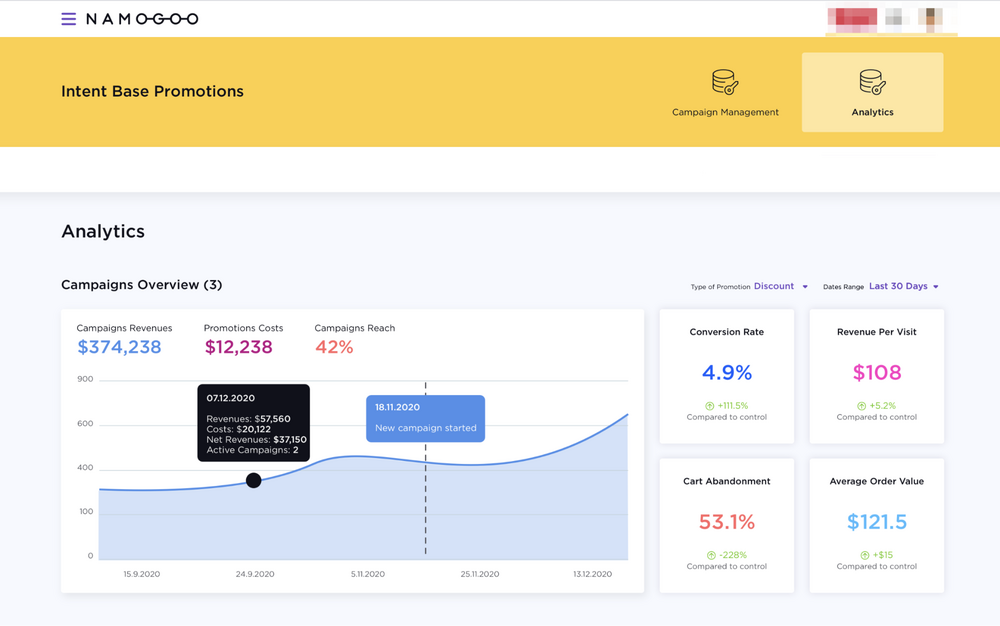 With this campaign, they saw:
With this campaign, they saw:
- 111% increase in conversion rate
- 5.2% increase in revenue per visitor
- 228% reduction in cart abandonment
- $15 increase in average order value.
Intent-Based Promotions offers personalized, one-to-session promotions, taking into account billions of data-points about customer buying behavior to calculate the purchase propensity and abandonment potential of each visit.
It then autonomously determines the minimum promotion needed to convert (if any) and serves the promotion on site.
It’s the new generation of behavioral segmentation: an individualized, hyper-targeted approach.
#3. More Precise Targeting
Behavioral segmentation enables you to be more precise in the targeting of your suspects, prospects, leads, and customers.
Precision in targeting is a crucial component of a profitable, sustainable marketing strategy. You saw my example above illustrating the different segmentation types using Facebook ad audiences.
By using behavioral segmentation, FLIGHTFŪD was able to reduce the audience size by half, omitting those who aren’t likely to become customers and focusing their spend on those who are.
Precision in targeting also helps you to:
- Prioritize your marketing budget and resource allocation to focus on the channels, customers, and prospects with the strongest return on investment.
- Optimize your strategy for reaching different types of customers to keep them engaged.
- Provide specific, tailored offers and promotions to reduce discount rates and increase conversions and profits.
#4. Optimize the Customer Journey
Segmenting customers based on their behavioral data can help you develop an understanding of what motivates each customer segment to convert or continue their customer journey.
This won’t be the same for every customer; what motivates somebody beginning their journey with your brand will not be the same as what motivates a VIP customer who has made several orders.
Behavioral segmentation can help you to understand where each customer is in their journey, and pair it with other valuable data to ensure continuity in each stage of the customer journey:
- Awareness: Allows for a deeper understanding of the customer’s intent so you can get in front of them with the right messaging and content on the right channels when they first become aware of their desire or problem to keep journeys flowing and engaging.
- Consideration: Optimize for conversions by using behavioral data and predictive analytics to provide the right promotion at the right time to the right people to ensure customer journey continuity as they enter the consideration stage and evaluate their options.
- Conversion: Improve revenue per visitor, average order value and cart size, because you can understand which customers are most likely to be up- or cross-sold, try new products, and appreciate add-ons.
- Customer Retention: By differentiating between shoppers with high purchase propensity, window shoppers and repeat customers, to tailor the customer experience to each group, providing the messaging they need to repurchase.
- Customer Advocacy and Loyalty: By helping you understand the key behaviors that lead to brand loyalty, so you can optimize the customer journey and marketing funnel to surprise and delight customers and win their support.
#5. Improve Customer Retention & CLTV
Some data suggests that a 5% improvement in customer retention can lead to 25%+ increase in profits[*].
Pair that with the fact that it costs anywhere from 5-25x more to attract a new customer than retain an existing one, and it’s hard to argue that existing, loyal customers are the most valuable to a business.
Behavioral segmentation allows you to identify your most valuable customers, and develop programs, content, and incentives to reward them and keep them happy and engaged.
9 Types of Behavioral Segmentation
Okay, so using analytics to build data-driven behavioral segments is a necessity in today’s eCommerce environment.
That’s clear.
But to put the wheels in motion, you need to understand what types of behavioral segmentation strategies exist, what data they rely on, and how each is used to:
- Increase conversions
- Improve customer retention
- Maximize profits.
There are nine common behavioral segmentation types.
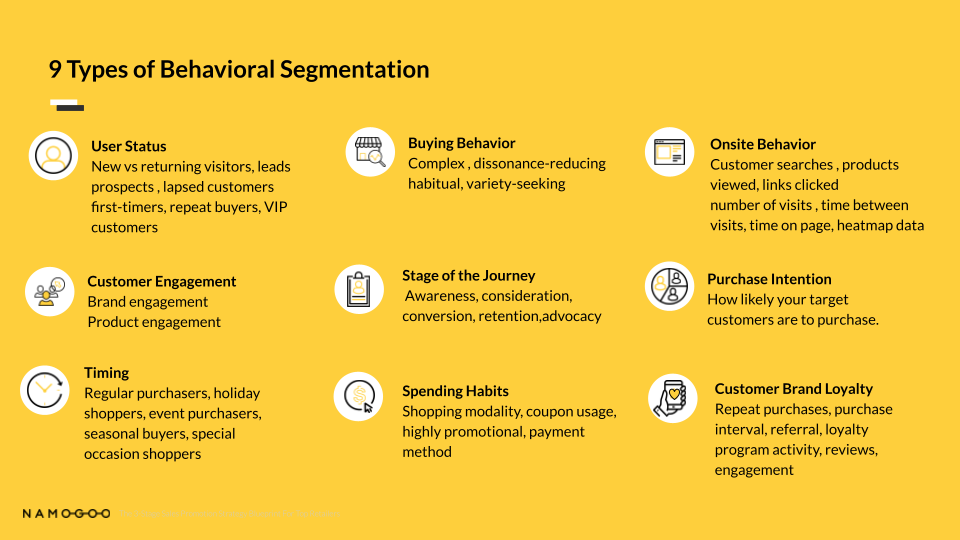
#1. User Status
This behavioral segmentation type groups customers based on their status with your brand.
User status groups include:
- New vs returning visitors
- Leads
- Prospects
- Lapsed customers
- First-time buyers
- Repeat buyers
- VIP customers
This is not to be confused with segmenting on the basis of customer journey stage, because segmenting based on user status is more granular.
There could be users in different status segments at each stage of the customer journey. For example, you could have both a lead and a prospect in the consideration stage, or a VIP customer and first-time buyer in the retention stage.
Segmenting based on user status enables personalized messaging, promotions, and onsite customer experience. It helps you target the right messaging and types of promotions to develop visitors into leads, and leads into first-time buyers.
#2. Buying Behavior
Also known as “purchasing behavior”, this type of behavioral segmentation groups customers based on where they land in one of the four patterns of buying behavior:
- Complex: Typically higher ticket purchases, or heavily emotional ones. Consumers that exhibit this buying behavior do not make these types of purchases often, and do a great deal of research, price comparison, etc. Think luxury goods and vehicle purchases.
- Dissonance-reducing: A step down from complex, dissonance-reducing buying behavior also requires considerable thought and involvement from the consumer, but they’ll struggle to identify differences between options, brands, or companies from which to buy.
- Habitual: Habitual buying behavior requires little research and consumer involvement; this type regularly purchases the products in question, with little thought to brands or brand loyalty.
- Variety-seeking: Like with habitual, this behavior is exhibited by consumers of a product that purchase regularly, but are open to trying new brands and types of products as they’re seeking novelty.
Most companies will see only a couple of these in their customer base and therefore won’t require segments for each type of buying behavior. For example, a fast-fashion brand is unlikely to require segments for complex and dissonance-reducing buying behavior.
Segmenting based on buying behavior can help you to develop content, advertisements, and marketing messaging to target the main behaviors your customers exhibit, allowing you to address common roadblocks in each.
#3. Onsite Behavior
This type of behavioral data segments customers based on the behaviors your visitors exhibit on your website. It’s also referred to sometimes as customer interaction.
Onsite behavior includes actions like:
- Pages landed on
- What the customer searched
- Products viewed
- Links clicked
- Form submissions
- Number of visits
- Time between visits
- Time on page
- Heatmap data.
Considering onsite behavior when building behavioral segments is a necessity, as it enables you to tailor the onsite customer experience and content to remove barriers to purchase and identify holes in your conversion funnel.
#4. Customer Engagement
There are two categories of customer engagement that behavioral segments can be built around: brand and product engagement.
Brand Engagement
This behavioral segmentation type looks at how often online shoppers interact with brands, and in what capacity.
There are three common types of users:
- Light users: Shop at a select few brands, suggesting higher customer loyalty. Generally have a lower AOV and shop online less. They’re less knowledgeable about the product and industry and are less sensitive to price variations between brands (likely due to their lack of knowledge)
- Medium users: Often grouped with light users, medium users tend to fall in the middle of light and heavy usage behaviors. Most users will fall here.
- Heavy users: Likely to engage in online shopping behaviors frequently, spend more on products, and use products in the category regularly. Heavy users:
- Buy more frequently
- Spend more money per transaction
- Shop at a wider variety of brands, suggesting lower brand loyalty
- Are knowledgeable and aware of trends, brands, and developments in the category.
Product Engagement
This behavioral segmentation type looks at how often your customers interact with your product, and in what capacity.
This differs from brand engagement because it groups existing customers and studies their usage patterns of your product.
Like with brand engagement, there are three types of users:
- Light product users: Customers who only occasionally use the product, or use it regularly but only use a limited amount of features.
- Medium product users: Your average customer who uses the product somewhat regularly, though not habitually, and may use and be aware of more features than light users, though don’t use the product to the maximum capacity.
- Heavy product users: These are the 80/20 customers: they only make up 20% of your customers, but they’re responsible for 80% of the revenue. They use the product habitually and to its full extent.
In software, this might be usage rate, whether they’re a heavy user or light user of the software or app. Behavioral segmentation can help SaaS companies identify the behaviors typical of each user type to develop resources, content, and promotions to reduce customer churn.
For example, one of Namogoo’s customers, the freelance platform Upwork, can use behavioral data about how their users engage with the platform to create a product engagement segment. They might then use that data to promote a customer referral program to their heavy users, and craft content to show their light users how best to use the platform.
In eCommerce, this looks different, since you can’t gather data on exact customer behavior like you can in-app. Instead, we’re using data on the purchase frequency, cross-platform interactions with the brand, and onsite behavior to group these customers.
As an example, a heavy user of Dollar Shave Club’s products would likely be on a subscription and use the products every time they shave. They may even buy individual products outside of their subscription. A light user, on the other hand, wouldn’t be on a subscription; they’d buy a product occasionally, and not use the products regularly.
This type of behavioral segmentation helps you to develop lifecycle marketing and customer success material to reduce churn and increase customer retention and loyalty.
#5. Stage of the Customer Journey
This type of behavioral data segments customers based on what stage they are in their customer journey, with the goal of ensuring journey continuity.
The customer journey is the process that each potential customer goes through with your company, from becoming aware of your brand to becoming a customer and beyond.
The five customer journey stages are:
- Awareness: The customer identifies they have a problem, need, or desire, and begins to research options to satisfy it.
- Consideration: The customer has done some initial research and is now comparing their options and gathering information.
- Conversion: Also called the decision phase, the conversion stage is where the potential customer makes a decision and converts.
- Retention: These are converted customers who you now want to turn into repeat buyers.
- Advocacy: The stage of the customer journey when your customer becomes a self-driven advocate for your products and brand, referring friends, creating user-generated content (UGC), posting glowing reviews, and providing valuable feedback.
Using behavioral data to segment based on the customer journey stage can help identify points of friction at each stage that cause the potential customer to fall off and address the barriers, moving them closer to conversion and then becoming a brand advocate.
For example, if there’s a disproportionate amount of customers that abandon their journeys at the consideration stage, develop resources and content to communicate your value propositions and differentiators to prevent your potential customers from choosing a competitor.
#6. Purchase Intention
This type of behavioral segmentation considers how likely your target customers are to purchase.
This is valuable because not every visitor that lands on your website will convert.
On each session, there’s a measure of intention to purchase. Some potential customers will convert on the first visit, some can be persuaded to eventually convert, and some will never convert.
The goal of segmenting based on customer purchase intention is to tailor your interactions to what the customer is likely to do and improve the customer experience. Data points that can inform intent to purchase include:
- What content they consume
- Which marketing channel they came from
- Their online buying behavior
- The timing of their interactions with your brand
- The devices they use
Segmenting based on the buyer’s intent will help you to drive CAC down and more profitably reach and convert your target customers.
#7. Timing
This behavioral segmentation type groups customers based on when they buy.
Some examples include:
- Regular purchasers: No occasion necessary, these customers buy regularly or habitually.
- Holiday shoppers: Customers who increase their online purchasing behavior around holidays such as Valentine’s day, Memorial Day, Christmas, and Father’s Day.
- Event purchasers: Buying behavior increases surrounding events like the Superbowl, or shopping events such as Black Friday.
- Seasonal buyers: Customers who are more likely to shop based on seasons, like those who shop more frequently in the summer or spring.
- Special occasion shoppers: Based on personal special occasions, such as birthdays and anniversaries.
Segmenting based on timing can help to inform purchase intent, and helps you to optimize for conversions and profitability by targeting customers when they’re most likely to buy.
#8. Spending Habits
This type of behavioral segmentation looks at how customers spend their money and when they buy.
It uses data such as:
- Shopping modality: Whether they buy in-store vs online, or through an online marketplace (i.e. Amazon, eBay) vs directly through the brand.
- Coupon usage: Whether the customer seeks and uses coupon codes.
- Highly promotional: Willingness to pay full price vs. buying a product only when it’s on sale.
- Payment method: Do they buy via credit card, debit card, or store card? Do they take advantage of paying in installments?
Using behavioral data to group customers based on spending habits can help you improve conversions while increasing profitability by tailoring your promotional offerings to what the customer is most likely to act upon.
#9. Customer Brand Loyalty
This type of behavioral segmentation groups existing customers based on how loyal they are to the brand.
The data might take into account:
- Repeat purchases: How many times the customer has bought from you
- Purchase interval: The time between purchases
- Referral: Whether the customer has driven referrals and how many
- Loyalty program activity: How engaged the customer is with your loyalty program
- Reviews: Whether the customer has left reviews for your product or brand, the platform used to leave the review, and the nature of the review.
- Engagement: How the customer engages and interacts with your brand across platforms, including following, sharing, posting user-generated content (UGC), etc.
Segmenting based on customer brand loyalty will help to reduce subscription churn, improve customer retention and LTV, and increase customer advocacy and referrals.
Many resources online cite “benefits sought” as a type of behavioral segmentation, but that’s not accurate.
It would be more accurate to say that behavioral data can give us an idea of what benefits our customers value about or seek from products, but the data that might lead us there can be collected in several of these types of behavioral segments.
Build Behavioral Data into Your Marketing Strategy
Using behavioral data and predictive analytics isn’t just a nice-to-have in today’s eCommerce landscape.
If you want to ensure long-term, sustainable revenue growth from your eCommerce or direct-to-consumer channels, it’s a necessity.
But manual behavioral segmentation is clunky and tough to manage. Your team doesn’t have time to build, track, and update robust behavioral segments.
Enter: the new generation of behavioral segmentation, Intent-Based Promotions.
Reap all of the benefits of behavioral segmentation and more, without any of the elbow grease with AI-powered predictive analytics engine that calculates the minimum promotion a customer needs to convert, based on their customer intent and behavioral data.
Tap into your site visitor’s intent and start seeing results today



